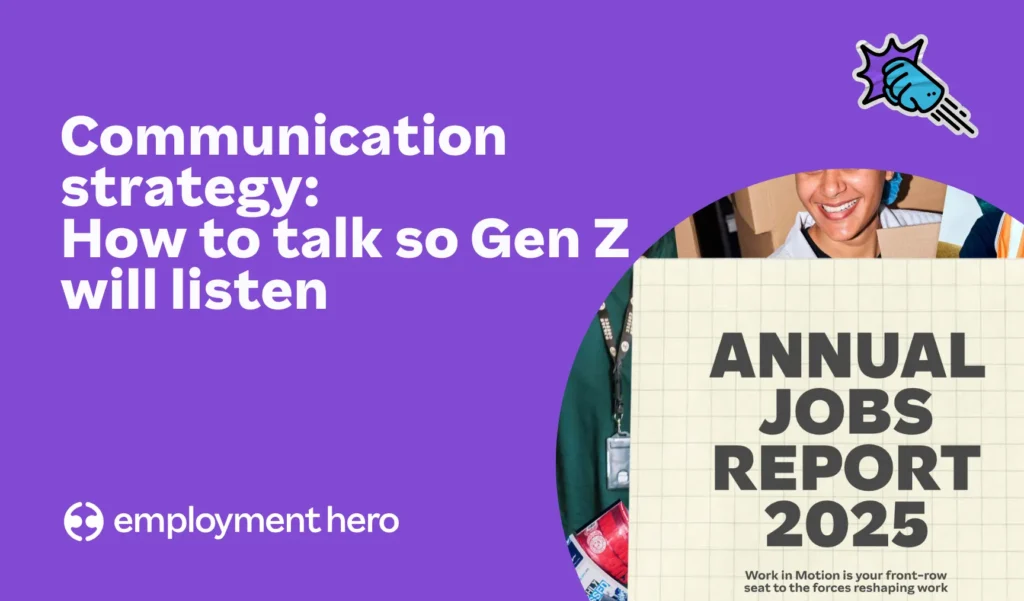Upskilling employees the smarter way in Canada

Contents
Canadian workers are rewriting the rules of employment. Gone are the days when a single job and a linear career ladder defined success. According to Employment Hero’s 2025 Annual Jobs Report, more than a third of Canadian full-time employees (35%) now juggle multiple jobs, the highest rate among surveyed countries. Rising costs are fuelling the shift, but so are shifting values.
For SMB owners, this new reality is a double-edged sword. On one side, talent is restless, harder to retain and more cautious about career commitments. On the other, employees are craving meaningful development and opportunities to grow. That’s where upskilling comes in.
Upskilling isn’t just about training. It’s about showing your employees — especially experienced ones — that your business can be the place where they future-proof their careers. In a market where job-hopping, poly-employment and burnout are on the rise, Canadian SMBs that invest in structured learning pathways, internal mobility programs and career progression frameworks will be the ones who keep their best people.
Let’s explore how.
Why Canadian SMBs can’t ignore mid-career upskilling
Mid-career employees are the backbone of any SMB. They carry institutional knowledge, mentor junior hires and deliver consistent results. But here’s the challenge: many are at risk of disengagement if they don’t see a future with you.
According to the Jobs Report, more than half of Canadian workers (53%) say they want jobs with less pressure and responsibility. This doesn’t mean they lack ambition — it means they want to grow on their own terms.
At the same time, poly-employment is on the rise. When more than one in three Canadians is holding multiple jobs, it’s a clear sign that employees are seeking both financial security and growth opportunities outside traditional employment. If SMBs fail to provide development and recognition, mid-career workers will simply look elsewhere or diversify their income streams.
By providing structured career pathways, SMBs can:
- Retain experienced talent who might otherwise seek stability elsewhere
- Reduce recruitment costs by promoting from within
- Build resilience against skills shortages in critical roles
Upskilling experienced employees isn’t just a nice-to-have. It’s a strategy that strengthens loyalty while building future capability.
Internal mobility programs that unlock hidden talent
Too many SMBs underestimate the potential of the people they already have. An internal mobility program changes that. Internal mobility means giving employees opportunities to move across functions, projects, or roles within your business. It’s more than just promotions — it includes job rotations, career pathing, and project-based assignments that let employees apply their skills in new ways.
Career pathing is often the backbone of mobility. It gives employees visibility into where they can go next and how to get there. For SMBs, this doesn’t have to mean building rigid hierarchies. Instead, focus on career lattices — non-linear pathways that allow for lateral growth alongside upward mobility. A career lattice vs ladder approach acknowledges that not everyone wants to climb straight up. Some employees may want to pivot into new functions, while others might want to deepen expertise as senior individual contributors. Offering both options keeps your workforce engaged and builds agility into your business. When employees can see these opportunities, they’re more likely to stay because they don’t feel locked into a single track. Internal job marketplaces make this even easier by giving employees visibility into open roles, short-term projects, and stretch assignments within your company.
Mapping skills to growth opportunities
You can’t upskill employees effectively without first knowing what skills your business needs. This is where skills gap analysis, skills mapping and competency matrices come in.
- Skills gap analysis: Identify the difference between the skills your team has today and what’s needed for the future
- Skills mapping: Build a visual map of employee skills across roles and teams
- Competency matrix: Define levels of proficiency for each skill, creating a clear framework for progression
For SMB owners, this might sound resource-heavy. But modern HR tech makes it simple. By digitizing skills audits, skills taxonomy and skills adjacency mapping, you can pinpoint who’s ready for advancement, who needs targeted development and where to invest in external hiring.
Skills adjacency is especially powerful. For example, an employee skilled in customer service may already have competencies that overlap with sales or account management. Identifying these adjacencies allows you to redeploy talent quickly and cost-effectively.
This data-driven approach makes career progression more transparent, fair and motivating for employees. And once you’ve mapped the skills, the next step is to turn that insight into actionable learning pathways.
Want to see how you can uncover hidden skills and launch learning pathways without complex spreadsheets?
Building personalized learning pathways for experienced employees
Upskilling works best when it feels personal. Generic training programs rarely resonate with mid-career staff who already bring years of expertise. What they need are individual development plans (IDPs), microlearning strategies and flexible learning pathways.
Individual development plans
An IDP template is a simple but powerful tool. It aligns employee goals with business needs. For example, if an experienced manager wants to grow into a strategic leadership role, their IDP might include project sponsorship, financial training and mentorship.
Microlearning strategy
Experienced employees are busy. Microlearning strategies — short, targeted lessons delivered on-demand — make upskilling realistic without pulling them away from core work. SMBs can leverage Employment Hero’s go1 e-learning platform, internal knowledge libraries, or even peer-led sessions.
Learning pathways
A structured learning pathway outlines how an employee can move from beginner to expert in a skill area. For SMBs, this could mean creating step-by-step tracks in leadership, digital tools, or industry-specific regulations.
Add tuition reimbursement, learning stipends, or sponsored certifications and you’ve created a compelling reason for experienced staff to stay.
Mentorship and capability academies as growth engines
Upskilling doesn’t always come from formal training. Some of the most valuable development comes through internal mentorship programs, sponsorship programs and capability academies.
Mentorship programs
A structured mentorship program connects experienced employees with peers or leaders who can guide their development. For SMBs, this is low-cost but high-impact. It builds community, strengthens knowledge sharing and helps employees envision their own career maps.
Sponsorship programs
While mentorship is about guidance, sponsorship programs go further by pairing employees with leaders who actively advocate for their advancement. For mid-career employees who feel stuck, sponsorship provides the visibility and backing they need to step into new roles.
Capability academies
A capability academy takes things further. Think of it as an internal hub where employees continuously build skills aligned to business priorities. SMBs don’t need the scale of a big corporation to create one. Even a small, curated program of workshops, online modules and manager coaching can form the backbone of an academy.
Mentorship, sponsorship and academies also support succession planning, ensuring your SMB is ready for leadership transitions without scrambling externally.
From career ladders to lattices: a new blueprint for career progression
Canadian employees are rejecting rigid hierarchies. Traditional career ladders — where every promotion comes with more responsibility and pressure — are falling out of favour. In fact, the Jobs Report shows that many workers, especially in Quebec, prefer less stressful roles over high-stakes advancement.
The solution? Career lattices. Career lattices let employees move laterally, building breadth instead of just climbing vertically This shift is particularly important for senior individual contributors — employees who want to deepen expertise rather than chase management roles. Offering lattices alongside ladders ensures your business keeps top performers engaged on their own terms.
Why upskilling is a retention strategy, not just L&D
Upskilling isn’t an HR checkbox. It’s a loyalty strategy.
Replacing an experienced employee can cost anywhere from half to double their annual salary once you factor in recruitment, training and lost productivity. For SMBs already managing tight margins, those costs are significant.
Upskilling is a more sustainable alternative. By investing in career progression frameworks, job rotations and capability building, SMBs signal to employees that they’re committed to long-term development. That’s more powerful than one-off perks or pay raises.
The data backs it up: Canadian workers are pragmatic. They’re open to change, but cautious about risk. By offering structured growth frameworks, skills matrices and learning pathways, SMBs create workplaces where employees want to stay and thrive.
How Employment Hero supports upskilling in Canadian SMBs
At Employment Hero, we know SMBs don’t always have the luxury of big HR teams or enterprise budgets. That’s why our platform includes tools that make career development and professional growth simple and accessible.
With Employment Hero, you can:
- Build personalized development plans that connect employee goals with business needs
- Map skills and create clear career pathways to help employees see their next steps
- Support internal mobility by opening up opportunities for projects, mentoring and role progression within your SMB
- Track employee goals, performance, and growth over time with built-in reporting and analytics
Upskilling doesn’t need to be complex. With the right tools, you can create learning pathways that keep employees motivated while preparing your business for the future.
Ready to turn upskilling into your best advantage?
Your experienced employees don’t just want higher salaries. They want purposeful development, reliable support and a clear path forward — and they’ll find it with the SMBs that invest in upskilling. Don’t wait until your top talent starts looking elsewhere.
Explore how Employment Hero helps Canadian SMBs build learning pathways that retain top talent today
FAQs on upskilling employees in Canadian SMBs
A skills gap analysis identifies the difference between the skills your workforce has today and what it needs for tomorrow. For SMBs, it prevents wasted training investments and pinpoints where to focus development.
A career ladder is linear — each step means more responsibility. A career lattice allows for lateral movement across functions, giving employees more flexibility to shape their careers.
An IDP template is a structured plan aligning an employee’s career goals with business objectives. It typically includes skill development, mentorship and measurable milestones.
Mentorship programs provide employees with guidance, growth and connection. For SMBs, they’re a cost-effective way to build loyalty and transfer knowledge across generations.
A capability academy is a structured learning hub focused on skills that matter most to your business. SMBs can start small with curated workshops, e-learning modules and manager coaching sessions.
Succession planning ensures leadership continuity. By linking it to learning pathways, SMBs can prepare mid-career employees to step into critical roles, reducing risk when transitions happen.
Start with transparency. Publish open roles internally, create career maps and encourage job rotations. Even small businesses can offer meaningful mobility when they make opportunities visible.
Related Resources
-
 Read more: 8 Email Holiday Templates for Every Workplace
Read more: 8 Email Holiday Templates for Every Workplace8 Email Holiday Templates for Every Workplace
Struggling to write your out-of-office message? Copy our 8 free holiday email templates for Christmas and New Year to set…
-
 Read more: 2025 federal budget: What Canadian employers need to know
Read more: 2025 federal budget: What Canadian employers need to know2025 federal budget: What Canadian employers need to know
Discover what Canada’s 2025 federal budget means for employers, from enhanced SR&ED incentives to new talent and funding opportunities.
-
 Read more: What tech founders should know about the 2025 federal budget and why this year is the perfect time to double down on SR&ED
Read more: What tech founders should know about the 2025 federal budget and why this year is the perfect time to double down on SR&EDWhat tech founders should know about the 2025 federal budget and why this year is the perfect time to double down on SR&ED
Discover how the 2025 federal budget enhances SR&ED for Canadian startups. Learn how founders can maximize refunds, extend runway and…


















